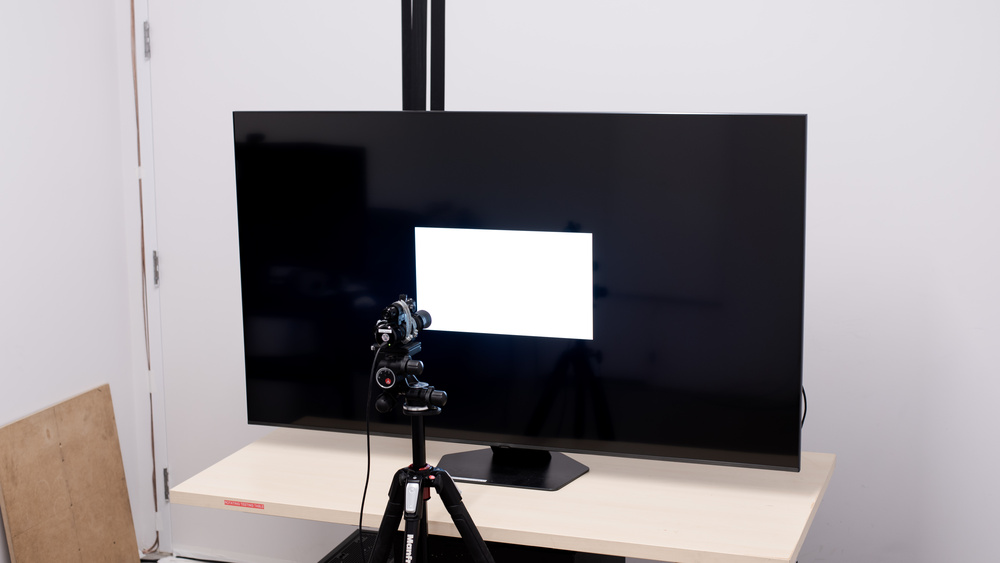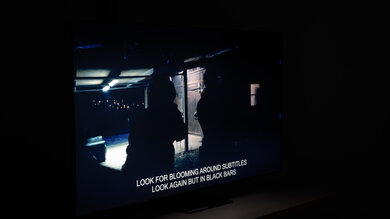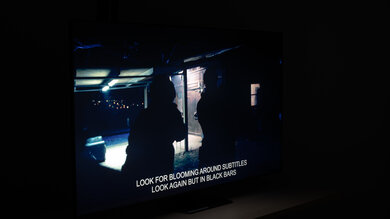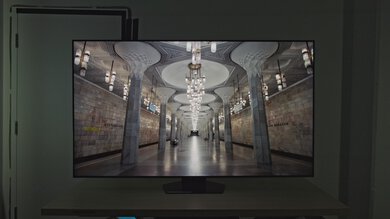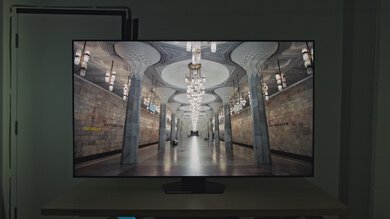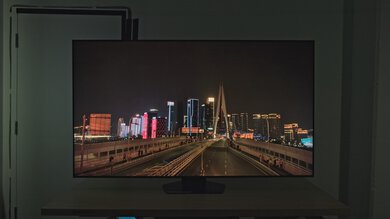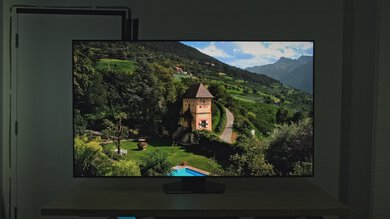The Samsung Q80D QLED is the highest-end model in Samsung's QLED range, which sits below their higher-end Neo QLEDs and succeeds the Samsung Q80C. Like its predecessor, the Q80D has Direct Full Array backlighting, with LEDs placed directly behind the LCD panel, allowing for a much tighter control of each dimming zone. It has Samsung's new NQ4 AI Gen2 Processor, which is meant to help with the TV's 4k upscaling, and it supports up to 4k @ 120Hz, with full VRR capabilities, on all four of its HDMI 2.1 ports. As usual with Samsung, the TV supports the HDR10+ format but not Dolby Vision, and it passes through advanced audio formats from Dolby but not from DTS. We bought and tested the 65-inch model, and it's available in five different size variants, although the 50-inch model is limited to 4k @ 60Hz. It was replaced in 2025 by the Samsung QN80F, which, despite the change in naming convention, uses a very similar backlight.
Our Verdict
The Samsung Q80D is a very good general-purpose TV. Its standout features are its impressive SDR peak brightness combined with the TV's decent reflection handling; this makes the TV quite good in any bright room scenario, from watching TV shows or sports, using the TV as a PC monitor, or playing video games. It's also a great choice to watch HDR content in dark rooms due to its fantastic contrast and good HDR brightness; HDR content is impactful on this TV. For gamers, the TV has 4k @ 120Hz support and incredibly low input lag, although its response time isn't quite good enough for a truly responsive gaming experience when playing fast-moving games.
-
Decent reflection handling.
-
Fantastic contrast ratio.
-
Some uniformity issues.
-
Inadequate viewing angle.
The Samsung Q80D is a decent TV for watching shows in a bright room. It gets very bright in SDR and has decent reflection handling, so your shows will be clear even with some lights on. The TV also has good low-resolution upscaling, so older shows on DVDs, or even shows on cable, look good and crisp with minimal issues. Unfortunately, it has only okay low-quality content smoothing, so low-bitrate content from streaming apps have some missing details and macro-blocking in dark scenes. It's not the TV for you if you're hoping to host large TV show watch parties, as its viewing angle is disappointing; the image degrades noticeably when viewed at an angle.
-
Excellent SDR peak brightness.
-
Decent reflection handling.
-
Some uniformity issues.
-
Just alright low-quality content smoothing.
-
Inadequate viewing angle.
The Samsung Q80D is decent for sports. It has an excellent SDR peak brightness and decent reflection handling, so sports are clear and vibrant even when watched in a brighter room. The TV's decent response time means that fast-moving objects, like a puck in hockey, are somewhat crisp, but there's still some noticeable blur behind fast-moving objects or players. If you watch a lot of sports with large areas of bright uniform color, like hockey, you'll notice that the edges of the screen are darker than the center due to its only alright gray uniformity. And if you're hoping to get this TV to watch sports with friends, perhaps look elsewhere, as its viewing angle just isn't good enough; its image degrades noticeably when viewed at an angle.
-
Excellent SDR peak brightness.
-
Decent reflection handling.
-
Some uniformity issues.
-
Just alright low-quality content smoothing.
-
Inadequate viewing angle.
The Samsung Q80D is a great TV on which to play video games. It has a ton of gaming features: 120Hz support on all four HDMI ports, full VRR capability for a nearly tear-free gaming experience, and an extremely low input lag for a responsive gaming experience. Unfortunately, its response time is only decent, leading to some noticeable blur in fast-moving titles. Thankfully, its image quality is great, with fantastic contrast, excellent SDR brightness, and a wide color gamut, so your games will look vibrant on this TV. It even looks good in brighter rooms due to its brightness and decent reflection handling, although it'll look even better if you turn off a few lights.
-
Excellent SDR peak brightness.
-
HDMI 2.1 bandwidth with VRR support.
-
Incredibly low input lag.
-
Some uniformity issues.
-
Inadequate viewing angle.
-
Response time isn't good enough for fast movements.
The Samsung Q80D is great for HDR movies. While its HDR brightness is good but not exceptional, it makes up for it with its fantastic contrast ratio and wide color gamut; HDR content looks pleasant and impactful on this TV. It also has perfect judder performance, which removes judder from all sources, and excellent HDR gradient handling for a nearly banding-free viewing experience. It's even a great option for users who care about color accuracy, as its HDR accuracy is fantastic, alongside excellent SDR pre-calibration accuracy. Its biggest flaw is its low-quality content smoothing, so low bitrate content from streaming apps has some noticeable macro-blocking in dark scenes.
-
Automatically removes 24p judder from any source.
-
Good HDR brightness.
-
Has a wide color gamut.
-
Fantastic contrast ratio.
-
No Dolby Vision support.
-
No DTS audio passthrough.
-
Just alright low-quality content smoothing.
The Samsung Q80D is great for playing the latest triple-A HDR titles. It supports 4k @ 120Hz, so games are played at their highest resolution possible, with full VRR support for a nearly tear-free gaming experience. The TV's HDR brightness is better in Game Mode than in 'FILMMAKER' mode, so it offers a vibrant image when gaming, even more so due to the TV's truly fantastic contrast ratio. Unfortunately, the TV's response time is only decent, so while it's good enough for a responsive gaming experience, you'll notice some blur behind fast-moving objects.
-
HDMI 2.1 bandwidth with VRR support.
-
Incredibly low input lag.
-
Good HDR brightness.
-
Has a wide color gamut.
-
Fantastic contrast ratio.
-
No Dolby Vision support.
-
Response time isn't good enough for fast movements.
The Samsung Q80D is a very capable TV when used as a PC monitor. It has excellent SDR brightness and decent reflection handling, so it looks bright even in a bright office. The TV has incredibly low input lag, so the mouse cursor flies on the screen almost as soon as you touch the mouse, but there is a slight blur trail behind it due to the TV's only decent response time. It has full chroma 4:4:4 capabilities at all supported resolutions except 1440p @ 120Hz, and its BGR panel doesn't offer the best possible text clarity, it's still sharp enough that most people won't notice. Unfortunately, its viewing angle is inadequate, so you'll notice some color shifting on the sides of the panel when sitting close to it, especially if you're using one of the larger sizes of the TV as a monitor.
-
Excellent SDR peak brightness.
-
Decent reflection handling.
-
HDMI 2.1 bandwidth with VRR support.
-
Incredibly low input lag.
-
Some uniformity issues.
-
Inadequate viewing angle.
-
Response time isn't good enough for fast movements.
- 7.9 Mixed Usage
- 7.4 TV Shows
- 7.4 Sports
- 8.3 Video Games
- 8.2 HDR Movies
- 8.3 HDR Gaming
- 8.2 PC Monitor
Changelog
-
Updated Jul 16, 2025:
We bought and tested the 2025 revision to this TV, the Samsung QN80F, and added a note in the intro.
- Updated Oct 04, 2024: Review published.
- Updated Oct 01, 2024: Early access published.
- Updated Sep 20, 2024: Our testers have started testing this product.
- Updated Jun 27, 2024: The product has arrived in our lab, and our testers will start evaluating it soon.
Check Price
Differences Between Sizes And Variants
We tested the 65-inch Samsung Q80D, and the results are valid for the 55, 75, and 85-inch models. The 50-inch model is limited to a 60Hz refresh rate and lacks features like VRR, Quantum HDR+, and Motion Xcelerator 120Hz. Otherwise, as usual, the last four letters of the model code (in this case, FXZA) vary between regions and even retailers, and not all regions carry all the variants. As Samsung's European lineup differs, these results are only valid for the North American Q80D.
Costco and Sam's Club sell a variant of the TV with a slightly different model code. It comes with an extended warranty and some other store-specific perks, but it performs the same.
| Size | US Model | Refresh Rate | VRR | HDMI 2.1 | Costco/Sam's Club Variant |
|---|---|---|---|---|---|
| 50" | QN50Q80DAFXZA | 60Hz | Yes | No | - |
| 55" | QN55Q80DAFXZA | 120Hz | Yes | Yes | - |
| 65" | QN65Q80DAFXZA | 120Hz | Yes | Yes | QN65Q80DDFXZA |
| 75" | QN75Q80DAFXZA | 120Hz | Yes | Yes | QN75Q80DDFXZA |
| 85" | QN85Q80DAFXZA | 120Hz | Yes | Yes | QN85Q80DDFXZA |
Our unit was manufactured in March 2024, as seen on the label.
Compared To Other TVs
The Samsung Q80D is a good mid-range TV that's especially good in bright rooms when watching SDR content, as its SDR peak brightness is excellent. It's also a standout in dark rooms due to its fantastic contrast, and its HDR brightness, while not exceptional, is good enough to provide an impactful viewing experience in controlled lighting environments. It also comes with a full suite of gaming features, although its response time is not good enough to please gamers looking for the most responsive TV. Overall, this TV is a good purchase, but it's unfortunately overshadowed by models such as the TCL QM7/QM751G QLED and the Hisense U7N, both of which are sold for about the same price, or even cheaper, while offering better image quality in all content, as well as better overall gaming performance.
If you're still shopping, see our recommendations for the best TVs for sports, the best TVs for bright rooms, and the best TVs to use as a PC monitor. To learn more about the tests we do that inform our scores and recommendations, check out our article on how we test TVs.
The Samsung Q80D is better than the Samsung Q70D, as it offers a noticeable upgrade in every way. The Q80D has a local dimming feature, giving it way better contrast than the Q70D. The Q80D is also brighter in HDR and SDR, and has better color volume, so all content is more impactful on that model.
The Samsung Q80D QLED is much better than the Samsung Q60D. The Q80D is far brighter and has a much better contrast due to its local dimming feature. It also has better color volume, better image processing, and is more accurate out of the box. Gamers will appreciate the Q80D's 120Hz support with VRR, while the Q60D is limited to 60Hz without VRR. The only advantage of the Q60D over the Q80D is its slightly wider viewing angle.
The Sony X90L/X90CL is slightly better than the Samsung Q80D QLED. The Sony is a bit brighter overall and offers better color volume. The Samsung, however, delivers higher native contrast and superior black uniformity—although the Sony shows noticeably less blooming around bright elements against a dark background. As is typical for Sony, it also provides more advanced image processing. Gamers might lean toward the Samsung thanks to its lower input lag. The two TVs are closely matched, but the Sony holds a slight edge.
The Hisense U7N is a bit better than the Samsung Q80D. While their contrast is comparable, the Hisense has the better local dimming solution, giving it better blooming performance as well as less noticeable lighting zone transitions. The Hisense is also noticeably brighter in HDR than the Samsung in real content, offering a more impactful HDR experience overall. While they're equally as bright in SDR, the Hisense has much better reflection handling, so it looks better in bright rooms. Finally, the Hisense is also better for gaming due to its faster response time and 4k @ 144Hz support.
The Samsung QN85D is better than the Samsung Q80D QLED in almost every way, but they're still closely matched. The QN85D has better contrast, is noticeably brighter in HDR and SDR, and has a wider color gamut. It also has better reflection handling, making it look better than the Q80D does in any room. The Q80D has slightly better upscaling performance, but overall, there's nothing else it does that's better than the QN85D.
Samsung has renamed the Q80 series this year, adding an 'N' to denote that it's part of their more premium Neo QLED Mini LED series. Sadly, the change in naming doesn't translate to performance, and the new Samsung QN80F isn't much different from the Samsung Q80D it replaces. Although they use the same processor, there are some minor changes in image processing, resulting in lower peak brightness for the QN80F, but everything else is pretty similar overall.
The Samsung Q80D is a slight but noticeable upgrade over the Samsung Q80C. The Q80D's local dimming feature is superior to the one used in the Q80C, giving the newer model far better contrast overall. The Q80D is also a bit brighter than its predecessor and is much more accurate in HDR and SDR out of the box. The older Q80C does have some advantages, such as a much wider viewing angle and a faster response time, but they don't quite make up for the Q80D's image quality advantage.
The TCL QM751G is better than the Samsung Q80D. The TCL has better black levels, and its local dimming feature performs better overall, giving the TV better blooming performance and less noticeable lighting zone transitions. The TCL is also far brighter in HDR content, and it has a wider color gamut, offering a more impactful HDR presentation than the Samsung. The TCL is also better for gamers due to its faster response time and 144Hz support. That said, the Samsung is more accurate in HDR and SDR out of the box, so consider it if you care about image accuracy.
Test Results
The Samsung Q80D looks nearly identical to the Samsung Q80C QLED but with a thicker silver bottom bezel. It has a clean hexagonal stand and a clean-looking design.
The center-mounted stand is small, so the TV doesn't require a large desk or media center. There's some side-to-side wobbling and a fair amount of front-to-back wobbling, but it settles relatively quickly. The stand lifts the screen 3.1 inches above the surface of your table, so almost every soundbar fits in front of it without blocking the screen.
Footprint of the 65-inch stand: 15.35" x 11.26".
The back panel is made of textured plastic with vertical etched lines. There are grooves in the casing to help with cable management, which then get funneled into the stand. The stand has a removable cover that helps with hiding cables. The inputs are recessed and are hard to access if the TV is wall-mounted.
The Samsung Q80D's build quality is very good. There's flex around the VESA holes and inputs on the back, and the TV is pretty shaky on its stand, although it quickly settles after being pushed. On our unit there's a noticeable gap at the back of the TV where the plastic panel meets the border. It shouldn't cause any issues, and otherwise, the TV has no problems with quality control.
The TV has just alright lighting zone transitions. Unfortunately, the leading edge of bright highlights when they quickly move across the screen is visibly dimmer, and there's very noticeable haloing, especially with smaller highlights.
The Samsung Q80D has good HDR brightness. While it's not bright enough to make bright highlights pop in complex scenes, it's still bright enough for highlights to stand out even when watched in brighter rooms, and it provides a pleasant HDR experience overall due to its fantastic contrast.
These measurements are after calibrating the HDR white point with the following settings:
- HDR Picture Mode: Filmmaker
- Brightness: 50
- Contrast: 50
- Color: 25
- HDR Tone Mapping: Static
- Color Tone: Warm 2
- Local Dimming: High
- Color Space: Auto
- Gamma: ST.2084 (0)
Results with 'HDR Tone Mapping' set to 'Active':
- Hallway Lights: 521 cd/m²
- Yellow Skyscraper: 452 cd/m²
- Landscape Pool: 160 cd/m²
The Samsung Q80D is slightly brighter in Game Mode, but it's less accurate.
These measurements are after calibrating the HDR white point with the following settings:
- HDR Picture Mode: Game
- Brightness: 50
- Contrast: 50
- Color: 25
- HDR Tone Mapping: Static
- Color Tone: Warm 2
- Color Space: Auto
- Gamma: ST.2084 (0)
- Game HDR: Basic
- HDR10+ Gaming: Basic
- Local Dimming: High
Results with HDR Tone Mapping set to 'Active':
- Hallway Lights: 472 cd/m²
- Yellow Skyscraper: 453 cd/m²
- Landscape Pool: 231 cd/m²
The Samsung Q80D has fantastic PQ EOTF tracking, as the TV follows the curve very closely until it reaches its maximum brightness. Still, it's not perfect, as, outside of some darker highlights, the TV is slightly overbrightened across the entire length of the curve. The TV behaves erratically once it hits its peak brightness with all mastered content, but it still rolls off to preserve detail in very bright highlights.
The Samsung Q80D has excellent peak brightness in SDR and easily overcomes glare in a well-lit room.
These measurements are after calibration with the following settings:
- Picture Mode: Movie
- Brightness: 50
- Contrast: 45
- Color Tone: Warm 2
- Gamma: 2.2
- Color: 25
- Local Dimming: High
The Samsung Q80D has a very good HDR color gamut. It has fantastic coverage of the commonly used DCI-P3 color space, so the vast majority of HDR content looks vibrant and pleasant to the eyes. Still, most colors are undersaturated and slightly off; greens are too yellow and magentas too red. The TV's coverage of the Rec. 2020 color space is alright, but all colors are even more undersaturated, and the more saturated greens and cyans show noticeable color mapping issues.
Our results were done in the TV's 'Native' Color Space, as 'Auto' slightly clamps blues and greens. Still, most users should leave the TV to 'Auto' for more balanced performance across a variety of contents. Here are our results in 'Auto' mode:
The TV has great color volume. Colors are bright and vibrant, and dark, saturated colors are displayed well due to its fantastic contrast.
The TV has excellent pre-calibration SDR accuracy. Blues and greens are slightly overrepresented in most shades of gray, and reds are underrepresented in mid-tones and pure whites. Overall, this leads to the TV's color temperature being slightly cooler than our 6500K target. Gamma is off of our 2.2 target, with most scenes being a bit too bright, while bright scenes are significantly overbrightened.
Overall, color accuracy is very good, although some colors, especially greens, are too saturated, and whites have noticeable color mapping issues.
The TV is easy to calibrate, and gamma, white balance, and color temperature are all nearly perfect afterward. Color accuracy is much better now, but all colors are still a little bit off the mark, albeit barely.
You can see our full calibration settings.
The Samsung Q80D has alright gray uniformity. The sides of the screen are quite a bit darker than the middle, and there's some dirty screen effect towards the center of the screen. Its uniformity on very dark or near-black screens is excellent, but the left side is a bit brighter than the rest, and there's some barely noticeable clouding throughout.
The Samsung Q80D has an inadequate viewing angle, so it's not suitable for a wide seating arrangement. There's significant gamma shifting, black level rise, and brightness loss as you move off-center, and colors look increasingly washed out as you move further away to the sides.
The Samsung Q80D has satisfactory reflection handling. Its semi-gloss screen finish significantly reduces the intensity of indirect reflections, like when glare from a ceiling light isn't directly facing the screen. Unfortunately, the TV's handling of direct reflections is only alright, so reflections caused by something like a lamp positioned in front of the screen are distracting.
The TV has impressive HDR gradient handling, as there's minimal banding in all color bands except dark reds and blues, which have no noticeable banding.
The Samsung Q80D does a very good job at upscaling low-resolution content like DVDs or lower-resolution streams. Details are quite clear, but finer details are hard to make out.
Sharpness processing was calibrated with no over-sharpening for low-resolution content with the following settings:
- Sharpness: 5
- Picture Clarity Settings: Off
The TV uses a BGR (Blue-Green-Red) subpixel layout instead of the traditional RGB layout. This doesn't cause any issues for video or gaming content, but it can be a problem for PC monitor use as it impacts the text clarity, although not everyone will notice this.
The TV uses quantum dot color converters to produce red and green light, which can be seen in the spectral power distribution (SPD) chart.
The TV uses pulse-width modulation (PWM) to dim its backlight, which introduces flicker that can bother people who are sensitive to it. The amount of flicker varies depending on what picture mode the TV is set to and what settings you're using.
It flickers at a very fast 960Hz in the 'Movie' picture mode at all brightness levels. In all other picture modes, it flickers at a slower 120Hz at all brightness levels. With 'LED Clear Motion' enabled, the TV flickers at 60Hz.
The TV supports backlight strobing, more commonly known as black frame insertion (BFI). The feature is designed to improve the appearance of motion by strobing its backlight and reducing the amount of persistence blur. The BFI feature on the TV only flickers at 60Hz, and there's still some minor image duplication present.
This TV has an optional motion interpolation feature to improve the clarity of motion, but it doesn't work very well. Even slower-moving scenes have some noticeable artifacts and haloing present. In faster-moving scenes, it can't keep up, and there are distracting artifacts and haloing, and sometimes the TV stops interpolating altogether.
Due to the TV's slower response time, there's very little noticeable stutter when watching 24p content.
The TV automatically removes judder from all sources when watching movies or shows that are in 24p, even if they're in a 60Hz signal, like from a cable box.
The Samsung Q80D is compatible with all three variable refresh rate (VRR) formats, and it works across a very wide refresh rate range, which ensures that your games remain nearly tear-free when gaming. It also supports sources with Low-Frame-Compensation (LFC), which ensures your games remain nearly tear-free even when your frame rate drops very low.
This TV has incredibly low input lag when set to Game Mode, which ensures a very responsive gaming experience with very little delay between your actions with your controller or mouse and the action on-screen.
The Samsung Q80D supports all common resolutions up to 4k @ 120Hz. It displays chroma 4:4:4 properly with any signal, except 1440p @ 120Hz, as long as the input label is set to PC. 1440p @ 120Hz @ 4:4:4 is not supported.
The TV is fully compatible with everything the PS5 offers, like 1440p @ 120Hz and 4k @ 120Hz, as well as HDMI Forum VRR. It also supports Auto Low Latency Mode, so you don't have to worry about manually switching to Game Mode to get the lowest input lag.
The TV is fully compatible with almost everything the Xbox Series X|S offers, including 1440p @ 120Hz, 4k @ 120Hz, HDMI Forum VRR, and FreeSync Premium Pro. It also supports Auto Low Latency Mode, so you don't have to worry about manually switching to Game Mode to get the lowest input lag. Unfortunately, Dolby Vision isn't supported on the TV, so gaming in Dolby Vision isn't possible.
All four HDMI ports support the full 48 Gbps 2.1 bandwidth, which is great for connecting multiple modern consoles or high-end PCs to this TV. The TV doesn't support Dolby Vision, but it does support the less supported HDR10+ format. Its tuner also only supports ATSC 1.0, so you can't use it to watch over-the-air 4k content. Note that the 50-inch model of the Samsung Q80D is limited to HDMI 2.0 bandwidth on all four ports.
The TV has eARC support, which allows it to pass uncompressed high-quality audio from a connected source to your home theater system or soundbar. Unfortunately, it doesn't support any DTS formats commonly used on Blu-rays.
The Samsung QN80D has an alright frequency response. It does produce more bass than what we usually hear from TV speakers, but it comes at the cost of audible output frequency deviations when the TV is at max volume, so it doesn't sound quite right when you crank it up. There are also noticeable compression artifacts. At moderate listening levels, the TV's sound profile is clear, making dialogue easy to understand.
The Samsung Q80D has very good distortion performance. It's very balanced at a moderate listening volume, with barely any noticeable distortion. It's even decent when you crank it up to max volume, which is good as the TV doesn't get very loud to start with.
The Samsung QN80D has a great selection of apps, so it's easy to find your favorite content. You can also cast content from your phone onto the TV or play videos from a USB stick.
The remote is slim and compact, has quick access buttons for the most popular streaming apps, and is easy to use. The remote has a built-in rechargeable battery with a solar panel on the back of the remote. You can also recharge it via USB-C if it dies unexpectedly.
The TV is compatible with the Bixby and Alexa voice assistants, and its remote has an integrated microphone for voice commands. You can use your voice to launch apps, switch inputs, ask for the weather and time, and adjust certain settings like the TV's brightness.
A single button is located at the bottom right of the TV. You can use it to power the TV on/off, change channels, adjust the volume, and switch inputs. You can control the TV hands-free with your voice using the TV's built-in microphone, but you can also turn the microphone off using a small switch located next to the power button.
Comments
Samsung Q80D: Main Discussion
Let us know why you want us to review the product here, or encourage others to vote for this product.
Update: We bought and tested the 2025 revision to this TV, the Samsung QN80F, and added a note in the intro.
- 21010
My company just bought two of the 85" variants from Sams Club and the model number was QN85Q80DDFXZA. Might be worth adding to this page.
- 21010
We cover both in our settings page. The white balance settings at the bottom of the settings page are for SDR, and the settings for HDR are listed in the HDR White Point section closer to the top of the page.
Thanks for the reply and clarification now I understand I did the same settings on my TV they look good I have the same TV from Europe I hope the settings are accurate for my TV q80d qled
- 21010
Is the White Balance Settings for SDR or HDR Or for both? Because I tried it on a SDR the picture looks good. Please reply and Thanks for the settings.
We cover both in our settings page. The white balance settings at the bottom of the settings page are for SDR, and the settings for HDR are listed in the HDR White Point section closer to the top of the page.
- 21010
Is the White Balance Settings for SDR or HDR Or for both? Because I tried it on a SDR the picture looks good. Please reply and Thanks for the settings.
Edited 2 months ago: Because I forgot to say that I tried the White Balance Settings in SDR - 21010
Is this TV (75") intended to sit perfectly vertical once mounted on its included stand, or tilt back ever-so-slightly like some manufacturers do? Thanks.

